The Unification Epicenter of True Lightworkers
A curious disc-shaped flying object has been discovered on an old painting in the Biserica Manastirii, or Church of the Dominican Monastery, in the town of Sighisoara, Romania.
The object is similar to other disc-shaped UFOs seen in paintings and coins ranging from the 4th century to the 17th century.
According to Gilli Schechter and Hannan Sabat of the Israeli Extraterrestrials and UFOs Research Organization (EURA), they received a picture of the painting from Catalina Borta who took the photograph while visiting the monastery
Biserica Manastirii, or Church of the Dominican Monastery, in the town of Sighisoara, Romania. Sighisoara is believed to the birthplace of Vlad the Impaler, the inspiration for the legend of Dracula.
As you can see on the disc-shaped object is hovering over a building that is emitting smoke.
It also has a caption in German that reads "Israel, hoffe auf den HERRN," which translated means "Israel, put your hope in the Lord."
EURA explains that this is a quote from Psalms song of ascents, c.130 v.7.
The age of the painting is unknown, but monastery was originally built in the 14th century. It was later destroyed and rebuilt in the 17th century.
An unidentified flying object is visible over the house.
The EURA says that the caption in the painting probably dates it to after 1523, when the bible was translated into German.
Interestingly, a very similar object can be seen on a renaissance illustration in Rome detailed in a book "Prodigiorum liber" by historian and writer Julio Obsequens who is believed to have lived in the middle of the fourth century AD
In the book "Prodigiorum liber" an unknonw object is also visible in the skies.
The image in question is supposed to depict a round object that was seen at sunset with a "large beam of fire" to the right. This sighting is supposed to have taken place in 98 B.C.
So the question remains: Was this disc-shaped flying object perhaps visible and witnessed by many people in ancient times?
We also find this object on an old coin.
. UFO coin, 1680 - French Medal apparently commemorating a UFO sighting of a wheel like object in Renaissance France.
In France, there was a coin minted in 1680 that shows a hovering disc shaped UFO with what appears to be port holes or lights around the outer rim.
Was this object an extraterrestrial spacehip visiting different parts of the world?
Copyright © MessageToEagle.com.
Views: 61
Comment
-
Comment by Besimi on November 4, 2014 at 5:58pm
-
125+ Year Old Rhododendron “Tree” In
CanadaThis huge 125-year-old rhododendron is
technically not a tree – most are considered to be shrubs. You can find out
more about it here. (Image credits: reddit)144-Year-Old Wisteria In Japan
Image credits: tungnam.com.hkAt 1,990 square meters (about half an
acre), this huge wisteria is the largest of its kind in Japan . Read more
about it here. (Image credits: y-fu)Wind-Swept Trees In New Zealand
These trees on Slope Point, the southern
tip of New Zealand , grow at an angle because they’re constantly buffeted by
extreme antarctic winds. Find out more here. (Image credits: Seabird Nz)Beautiful Japanese Maple In Portland ,
OregonImage credits: falcor88Image credits: Tom SchwabelAntarctic Beech Draped In Hanging Moss In
OregonThe antarctic beech is native to Chile and
Argentina , though this specimen is from the U.S. ’ North Pacific region.
(Image credits: Drew Hopper)Blooming Cherry Trees in Bonn ,
GermanyThis beautiful tunnel of cherry blossoms
blooms in Bonn , Germany in April. (Image credits: Adas Meliauskas)Angel Oak In John’s Island In South
CarolinaThe Angel Oak in South Carolina stands
66.5 ft (20 m) tall and is estimated to be more than 1400 or 1500 years old.
(Image credits: Daniela Duncan)Flamboyant Tree , Brazil
http://www.boredpanda.com/blog/wp-content/uploads/2014/07/amazing-t..." border="0" height="660" width="880" />
The flamboyant tree is endemic to
Madagascar , but it grows in tropical areas around the world. (Image credits:
Salete T Silva)Dragonblood Trees, Yemen
http://www.boredpanda.com/blog/wp-content/uploads/2014/07/amazing-t..." border="0" height="583" width="880" />
The dragonblood tree earned its fearsome
name due to its crimson red sap, which is used as a dye and was used as a
violin varnish, an alchemical ingredient, and a folk remedy for various
ailments. (Image credits: Csilla Zelko)The President, Third-Largest Giant Sequoia
Tree In The World, Californiahttp://www.boredpanda.com/blog/wp-content/uploads/2014/07/amazing-t..." border="0" height="2357" width="880" />
President, located in Sequoia National
Park in California , stands 241 ft (73m) tall and has a ground circumference
of 93 ft (28m). It is the third largest giant sequoia in the world (second
if you count its branches in addition to its trunk). (Image credits: Michael
Nichols)Maple Tree Tunnel in Oregon
http://www.boredpanda.com/blog/wp-content/uploads/2014/07/amazing-t..." border="0" height="820" width="880" />
Image credits: Ian SaneRainbow Eucalyptus In Kauai ,
Hawaiihttp://www.boredpanda.com/blog/wp-content/uploads/2014/07/amazing-t..." border="0" height="1175" width="880" />
Image credits: jwilsonnortonhttp://www.boredpanda.com/blog/wp-content/uploads/2014/07/amazing-t..." border="0" height="587" width="880" />
The rainbow eucalyptus, which grows
throughout the South Pacific, is both useful and beautiful. It is prized for
both the colorful patches left by its shedding bark and for its pulpwood,
which is used to make paper. (Image credits: Christopher Martin)Jacarandas in Cullinan , South
Africahttp://www.boredpanda.com/blog/wp-content/uploads/2014/07/amazing-t..." border="0" height="1245" width="880" />
These beautiful Jacarandas, with their
violet flowers, grow in South Africa . (Image credits: Elizabeth Kendall)Avenue Of Oaks At Dixie Plantation In South
Carolinahttp://www.boredpanda.com/blog/wp-content/uploads/2014/07/amazing-t..." border="0" height="585" width="880" />
This avenue of oak trees was planted some
time in the 1790s on Dixie Plantation in South Carolina . (Image credits:
Lee Sosby)Baobab Trees In Madagascar
http://www.boredpanda.com/blog/wp-content/uploads/2014/07/amazing-t..." border="0" height="587" width="880" />
These baobabs in Madagascar are excellent
at storing water in their thick trunks to use during droughts. (Image
credits: confitalsurf)The Dark Hedges In Northern
Irelandhttp://www.boredpanda.com/blog/wp-content/uploads/2014/07/amazing-t..." border="0" height="852" width="880" />
Image credits: Stephen Emersonhttp://www.boredpanda.com/blog/wp-content/uploads/2014/07/amazing-t..." border="0" height="585" width="880" />
Ireland’s Dark Hedges were planted in the
18th century. This stunning beech tree tunnel was featured on Game of
Thrones as well.Views: 11
-
Comment by Besimi on November 2, 2014 at 10:43am
-
By Anna Liesowska
22 October 2014Scientists close to precise dating of the Shigir Idol, twice as ancient as the Egyptian Pyramids.
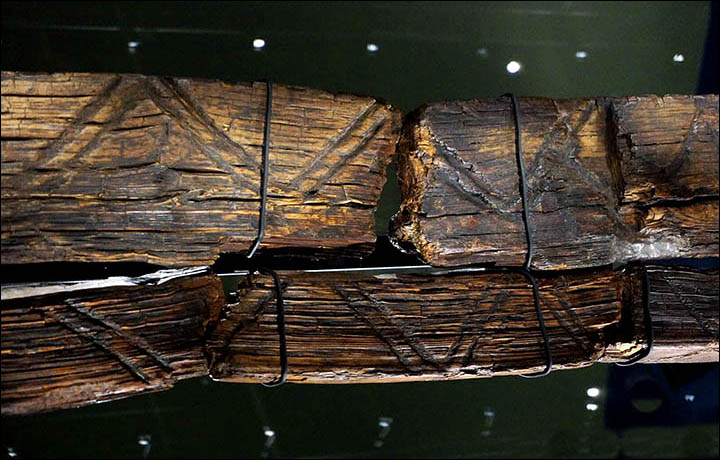
The oldest wooden statue in the world. Picture: Ekaterina Osintseva, The Siberian Times
The Idol is the oldest wooden statue in the world, estimated as having been constructed approximately 9,500 years ago, and preserved as if in a time capsule in a peat bog on the western fringe of Siberian. Expert Svetlana Savchenko, chief keeper of Shigir Idol, believes that the structure's faces carry encoded information from ancient man in the Mesolithic era of the Stone Age concerning their understanding of 'the creation of the world'.
German scientists are now close to a precise dating - within five decades - of the remarkable artifact, which is a stunning example of ancient man's creativity.
The results are likely to be known in late February or early March, The Siberian Times can reveal.
Now the question is turning among academics to a better understanding of the symbols and pictograms on this majestic larch Idol, one of Russia's great treasures, which is now on display a special glass sarcophagus at its permanent home, Yekaterinburg History Museum, where Savchenko is senior researcher.
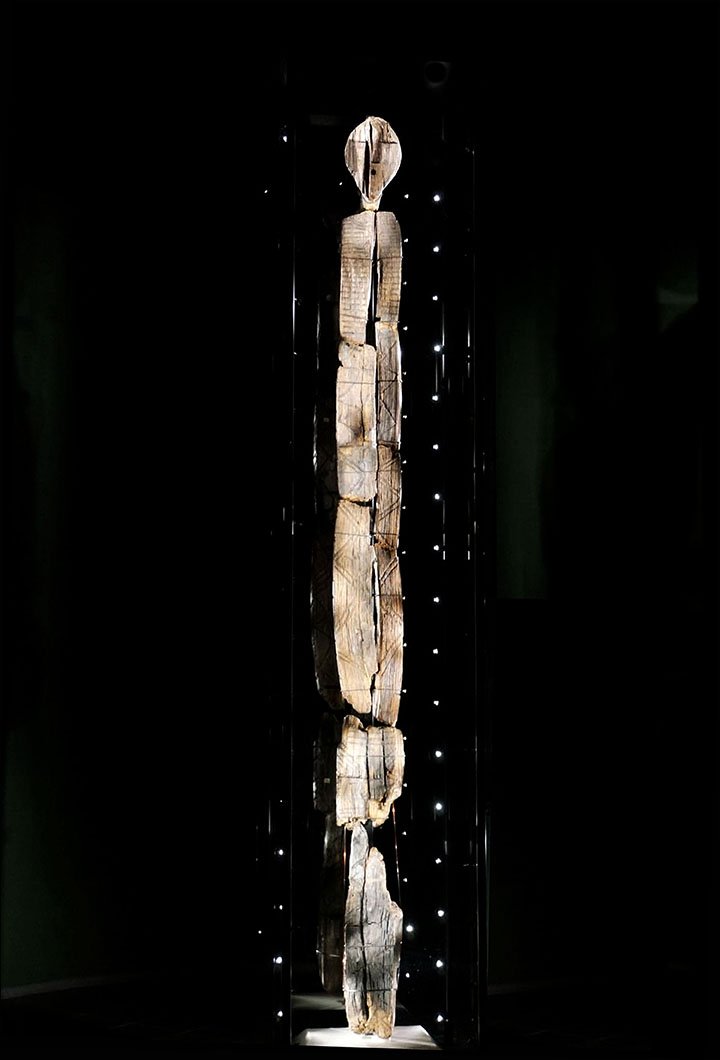
There is no such ancient sculpture in the whole of Europe. Picture: Ekaterina Osintseva, The Siberian Times
German pre-historian Professor Thomas Terberger said: 'There is no such ancient sculpture in the whole of Europe. Studying this Idol is a dream come true. We are expecting the first results of the test at the end of winter, (early) next year.'
Professor Mikhail Zhilin, leading researcher of the Russian Academy of Sciences' Institute of Archeology, explained: 'We study the Idol with a feeling of awe. This is a masterpiece, carrying gigantic emotional value and force. It is a unique sculpture, there is nothing else in the world like this. It is very alive, and very complicated at the same time.
'The ornament is covered with nothing but encrypted information. People were passing on knowledge with the help of the Idol.'
He is adamant that we can draw conclusions about the sophistication of the people who created this masterpiece, probably scraping the larch with a stone 'spoon', even though the detail of the code remains an utter mystery to modern man.
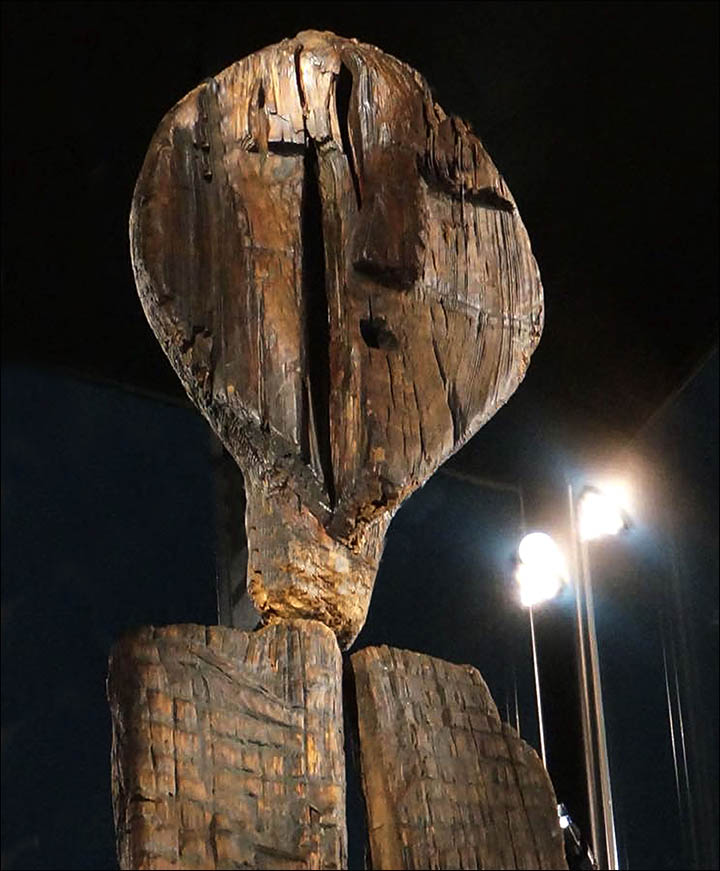
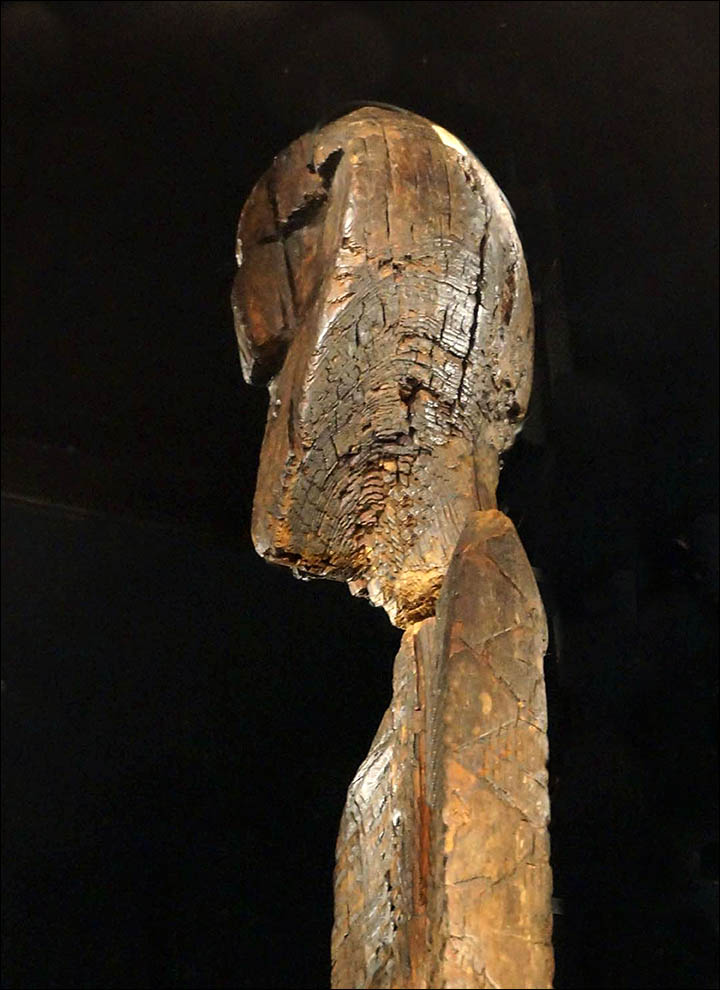
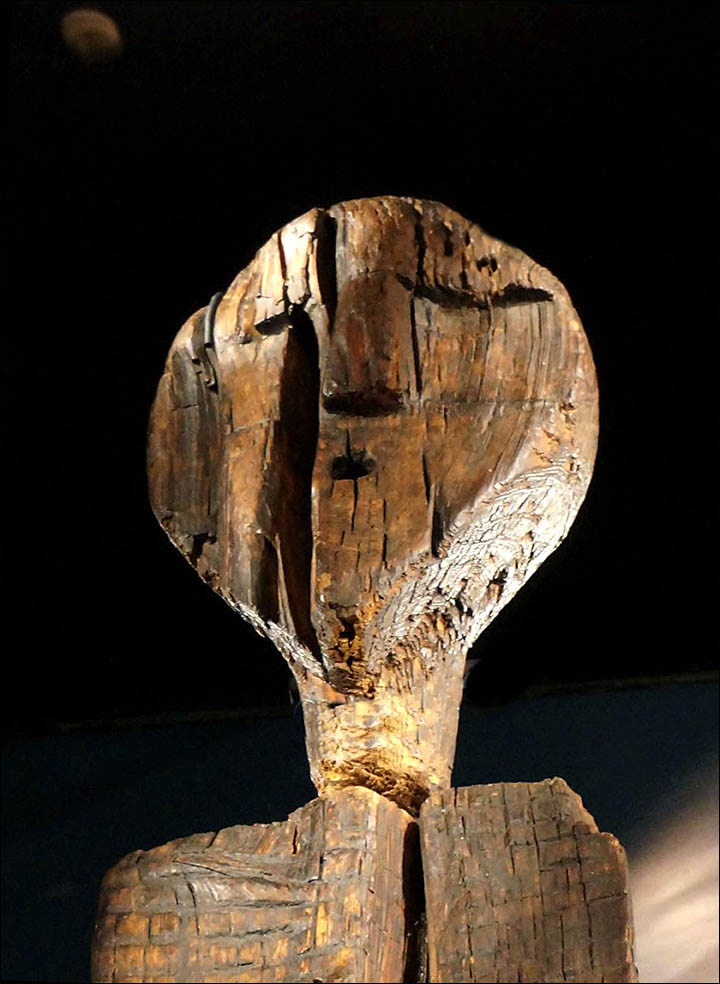
This is a masterpiece, carrying gigantic emotional value and force. Pictures: Ekaterina Osintseva, The Siberian Times
Asked if they lived in permanent fear of mighty forces of mysterious nature, nervously casting around, petrified by danger, he replied: 'Forget it. The men - or man - who created the Idol lived in total harmony with the world, had advanced intellectual development, and a complicated spiritual world.'
'It is obvious that the elements of geometrical ornament had some meaning,' stated Savchenko and Zhilin in explaining the Idol's ancient markings.
'The difficulty of interpretation is the polysemy symbolism of these symbols' - in other words, the possible multiple related meanings. According to ethnography, a straight line could denote land, or horizon - the boundary between earth and sky, water and sky, or the borderline between the worlds.
'A wavy line or zigzag symbolised the watery element, snake, lizard, or determined a certain border. In addition, the zigzag signaled danger, like a pike. Cross, rhombus, square, circle depicted the fire or the sun, and so on.'
Savchenko and other museum staff have postulated that among its purposes was that of an early map, or navigator. Straight lines, wave lines and arrows indicated ways of getting to the destination and the number of days for a journey, with waves meaning water path, straight lines meaning ravines, and arrows meaning hills, according to this theory which has yet to be fully researched.
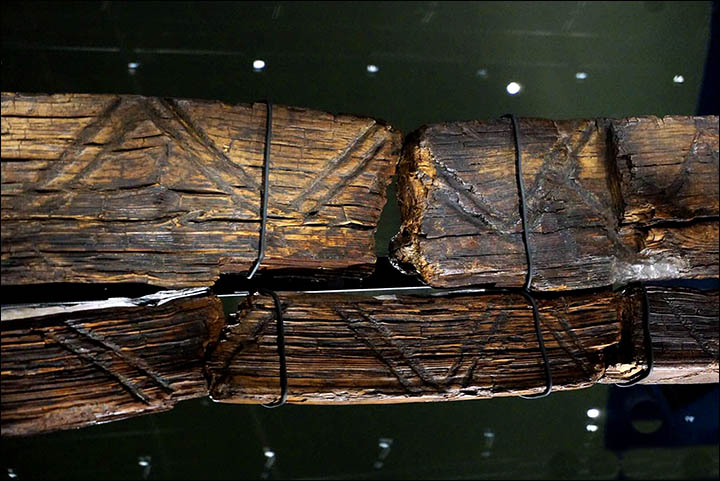
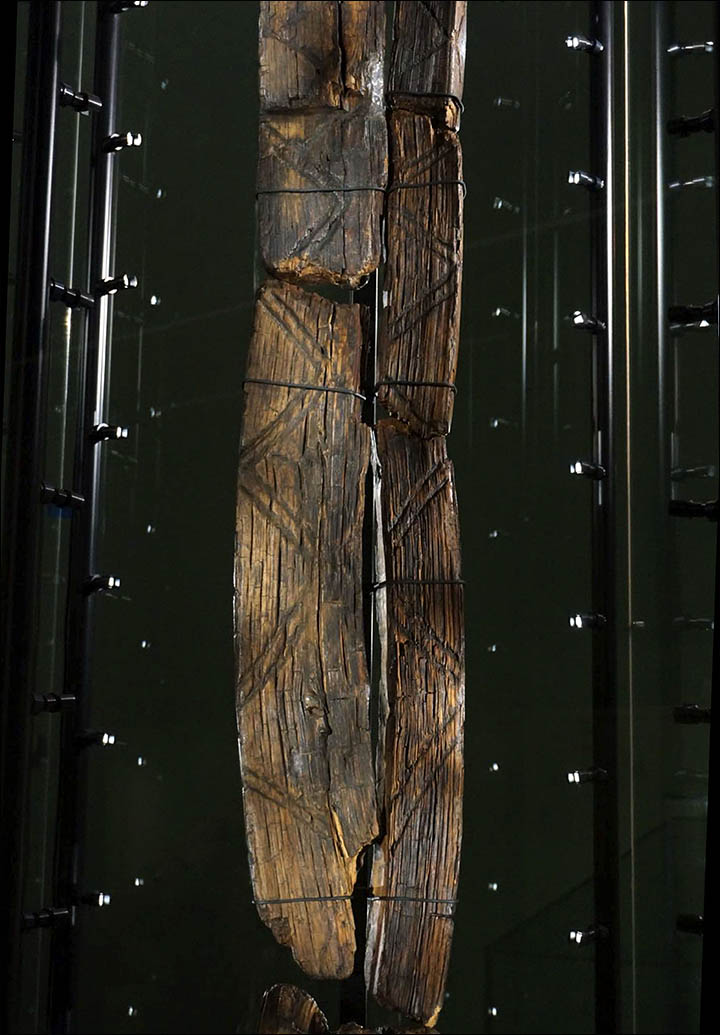
The ornament is covered with nothing but encrypted information. Pictures: Ekaterina Osintseva, The Siberian Times
Author Petr Zolin, citing scientific work by Savchenko and Zhilin, stated: 'The characters of Idol cannot have an unambiguous interpretation. If these are images of spirits that inhabited the human world in ancient times, the vertical position of figures (one above the other) probably relate to their hierarchy.
'Placing images on the front and back planes of the Idol, possibly indicate that they belong to different worlds. If there are depicted myths about the origin of humans and the world, the vertical arrangement of the images may reflect the sequence of events. Ornaments can be special signs which mark something as significant.'
The Idol reflects what these people looked like, with straight noses and high cheekbones.
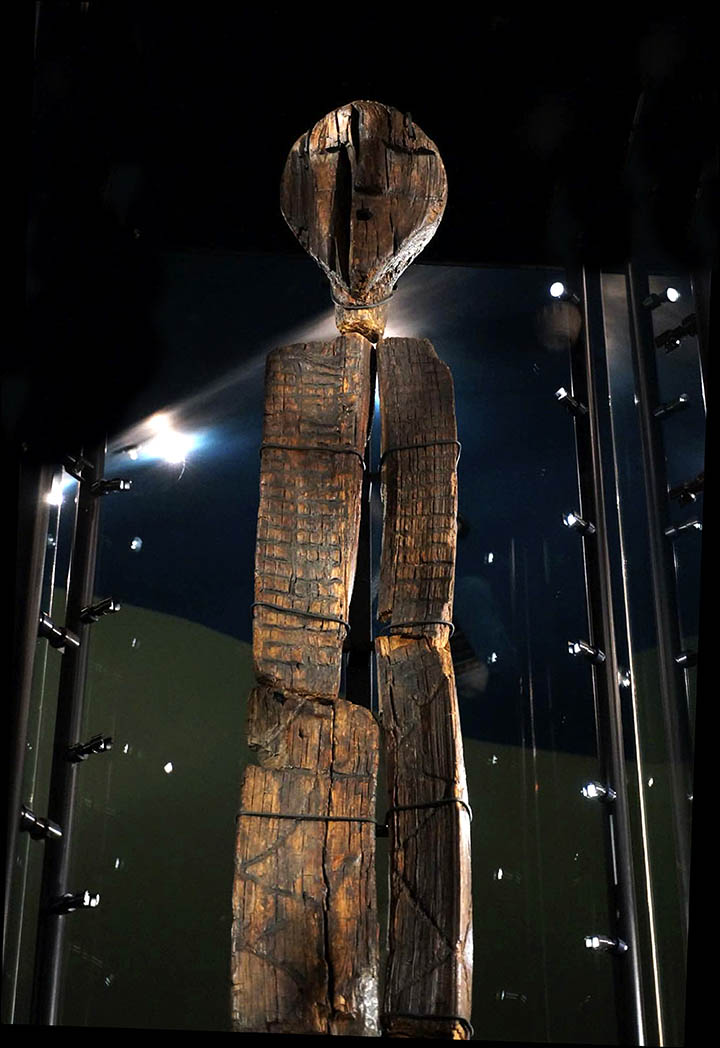
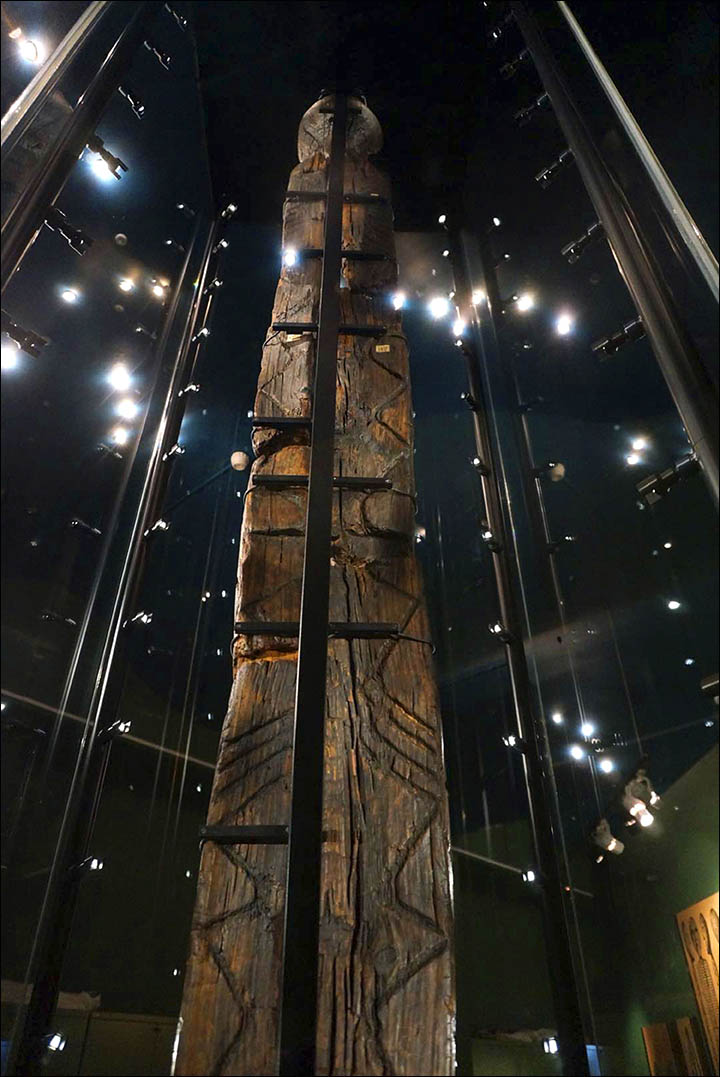
The men - or man - who created the Idol lived in total harmony with the world, had advanced intellectual development, and a complicated spiritual world. Pictures: Ekaterina Osintseva, The Siberian Times
The impression of the main three-dimensional face, with a gaping mouth, is of an Aztec look, but it is only because the part of the nose of the main face was broken. In all there are seven faces, six of which are one dimensional.
'It is clear that the faces together with the ornament form separate figures,' said Savchenko and Zhilin. 'On both the front and back of the Idol there are three figures. Here they are located one above the other, and the upper seventh figure...connects both sides and crowns the composition.'
Some have claimed the Idol includes primitive writing, which, if true, would be amongst the first on Earth, but there is no consensus among experts who have studied the Urals statue.
The Idol was preserved due to a stroke of luck concerning its resting place in the Urals.
It happened 'thanks to a combination of antiseptics,' said Professor Zhilin. 'The idol was made from the Phytoncidic larch, then 'canned' in turf which is an acid anaerobic environment that kills microorganism-destroyers and also has a tanning effect.'
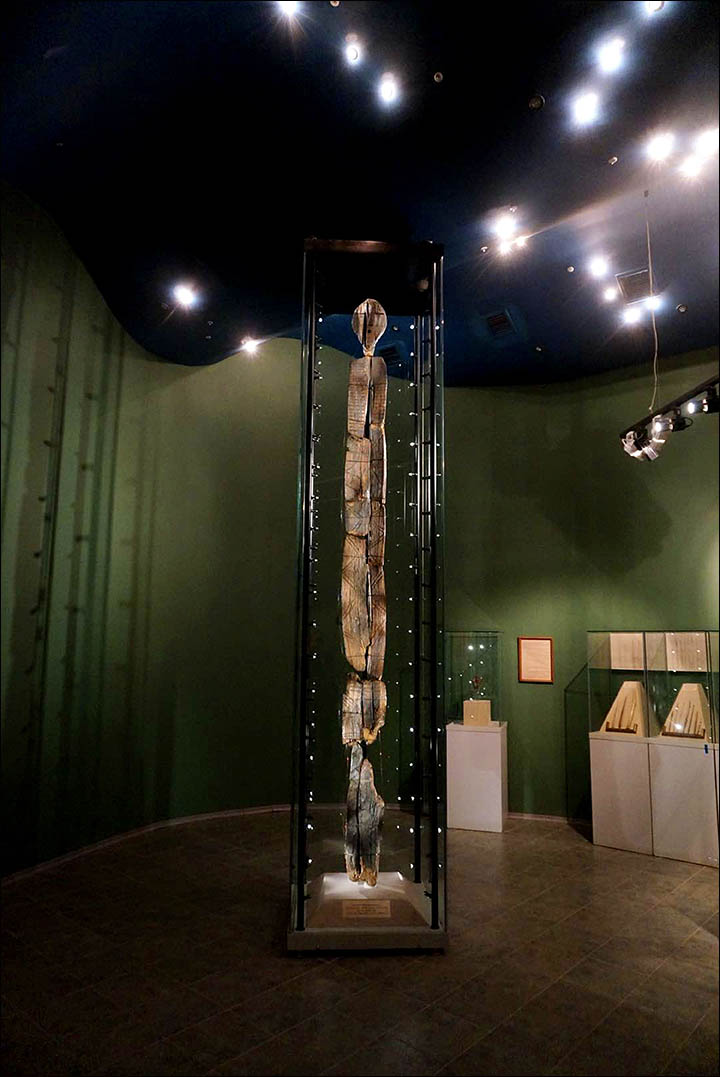
Some have claimed the Idol includes primitive writing, which, if true, would be amongst the first on Earth. Picture: Ekaterina Osintseva, The Siberian Times
The scientists from the Lower Saxony State Office for Cultural Heritage are using AMS - accelerated mass spectrometry - enabling them to compare analysis of five microscopic samples of the larch from the idol with climate changes data for the past 10,000 years.
This will allow them to figure out when exactly the 159 year old larch - from which the Idol is carved - grew.
The tests follow what Professor Terberger called 'a very successful summer trip' in which 'we worked together with our Russian colleagues from the Yekaterinburg History Museum'.
The Idol was originally recovered in January 1890 near Kirovograd; some 2.8 metres in height, it appears to have seven faces. It was protected down the millennia by a four metre layer of peat bog on the site of an open air gold mine.
Lack of funding has, until now, prevented the proper age testing of this Urals treasure. Professor Uwe Hoysner, from Berlin Archaeological Institute said: 'The Idol is carved from larch, which, as we see by the annual rings, was at least 159 years old. The samples we selected contain important information about the isotopes that correspond to the time when the tree grew.'
The samples used for testing were cut in 1997. The Idol was extracted in several parts from the peat bog.
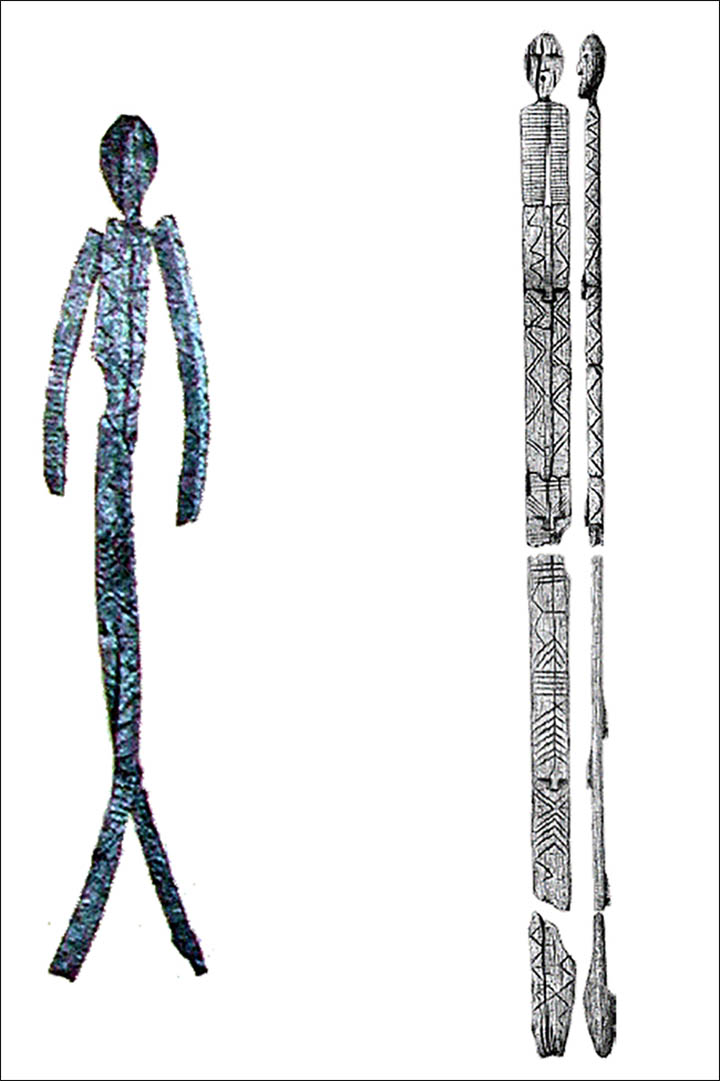
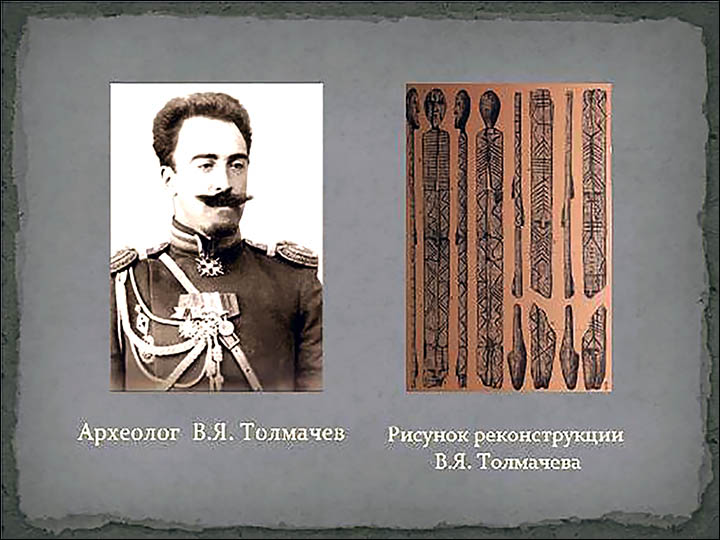
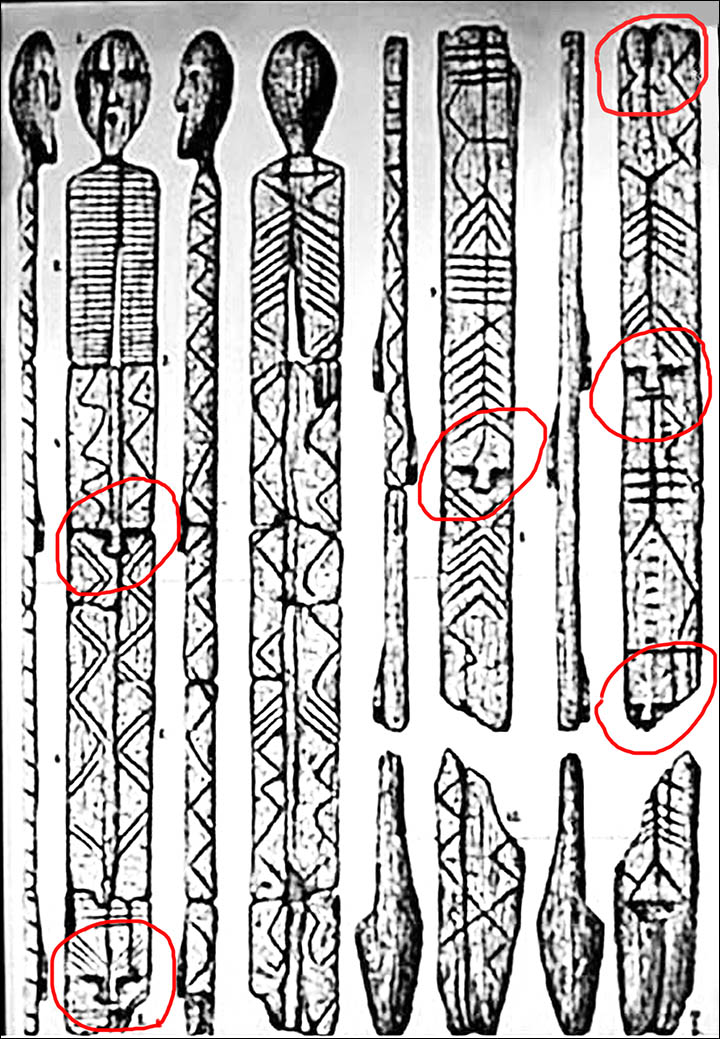
First reconstructions of the Idol as walking and standing upright, archeologist Vladimir Tolmachev and his drawings of the Idol, and marked faces of the Idol. Pictures: Yekaterinburg History Museum
Professor Dmitry. I. Lobanov combined the main fragments to reconstitute the sculpture 2.80m high but in 1914 the Siberian archaeologist Vladimir Tolmachev proposed a variant of this reconstruction by integrating previously unused fragments.
Tragically, some of these fragments were later lost, so only Tolmachev's drawings of them remain.However, these suggest the original height of the statue was 5.3 metres. Some 1.93 metres of the statue did not survive the 20th century's revolutions and wars and it is only visible on his drawings.
But even the size is it now makes it the highest wooden statue in the world.
One intriguing question debated by Russian scientists is how the Idol - as tall as a two-storey house - was kept in a vertical position.
Museum staff believe it was never dug into the ground to help it stand upright, and that it was unlikely it was perched against a tree, because it would have covered more than half of its ornaments.
http://siberiantimes.com/science/casestudy/features/is-this-the-wor...
© 2026 Created by Besimi.
Powered by
![]()













You need to be a member of Saviors Of Earth to add comments!
Join Saviors Of Earth